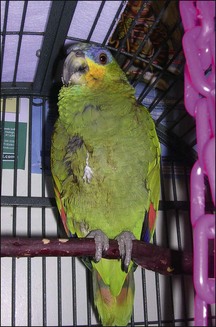13 Feather plucking in a parrot
Introduction
CASE PRESENTING SIGNS
A 1-year-old orange-winged Amazon parrot (Amazona amazonica) (Fig. 13.1, Box 13.1) was presented for nail clipping. It became evident during the consultation that the bird had been plucking feathers for the previous 2 weeks.
BOX 13.1 Ecology of Amazon parrots
• Amazon parrots (Amazona spp) originate from central South America. Orange-winged Amazons are located in Columbia, Trinidad and Tobago, with their range extending south to Peru and central Brazil. They reside in forest and semi-open country.
• Amazons are sexually monomorphic. Gender identification is by DNA analysis of blood or feather pulp, or visualization of the gonads via coelioscopy.
• The diet in the wild consists of various seeds and fruits, including fruit from palm trees and sometimes cocoa.
Clinical Examination
• Weight 480 g, overweight (keel not palpable due to fat layer overlying, usual weight range for the species is 440–470 g)
DIFFERENTIAL DIAGNOSES
The medical differentials for feather plucking were:
• Malnutrition (’stress’ marks (horizontal bars or weaknesses) are usually present on the feathers, associated with interrupted feather growth): general malnutrition or specific (e.g. omega-3 fatty acid deficiency, excess salt)
• Toxins, e.g. nicotine exposure (other signs may include excitability, vomiting, diarrhoea, and seizures), heavy metal toxicosis
• Infectious causes of feather dystrophy (may present similarly to self-feather plucking, but the head may also be involved): psittacine beak and feather disease (PBFD, circovirus), polyomavirus (in older budgerigars that survive infection), ‘French moult’ (budgerigars, caused by PBFD or polyomavirus)
• Dermatitis, e.g. skin irritation, skin desiccation, folliculitis (bacterial or fungal), polyfolliculosis in lovebirds (usually ventral neck or dorsum, may be infectious aetiology (e.g. polyomavirus) or secondary to self-trauma)
• Hypothyroidism (few documented cases; ‘normal’ avian total thyroxine levels vary with species and season, so diagnosis is difficult)
The behavioural differentials for feather plucking were:




